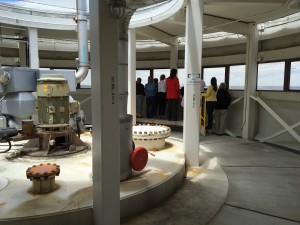Colleagues See Wastewater “Eggs” up Close
By Amy Miller
When my corner of EPA New England – the Public Affairs office – went on a retreat last week, we took our meeting to the great beyond. Instead of meeting in a generic conference room in our office, a dozen or two of my closest colleagues and I went out to the world that gives our work meaning.
To be specific, we met at the Giant Eggs. Most anyone who flies in or out of Logan Airport knows about these huge white containers, a dozen eggs sitting on the edge of the Boston Harbor on Deer Island off of the Town of Winthrop. On a clear day, you can’t miss the sight of these ovals reaching 130 feet high.
What jet passengers may not know is that these containers are filled with human and industrial waste. Each day the Deer Island Sewage Treatment Plant accepts an average of 360 million gallons of wastewater from homes and businesses in 43 cities and towns. This facility, run by the Massachusetts Water Resources Authority, makes sure our sewage is separated enough, filtered enough, treated enough and clean enough to safely enter the Boston’s waters.
To accomplish this, the plant first removes grit, then treats and retreats the wastes, which are separated by gravity into liquids and solids. The effluent is filtered, scum removed from sludge, treated with chemicals and digested using microorganisms, much the way a stomach digests food. Treated solids are sent through a tunnel to Quincy so it can be turned into fertilizer. Water that has been cleaned many times over is sent 10 miles out to sea and discharged through 50 different pipes. And methane released in the digestion process is used to heat the facility.
In welcoming us to the plant, Executive Director Fred Laskey acknowledged there is still work to be done. But he was proud of the tremendous results the plant has seen. Largely because of $3.8 billion invested in Deer Island in the last several decades, the cleanup of Boston Harbor is a national environmental success story. Plant Director Dave Duest eagerly invited us to tour the plant, which sits on 210 acres that includes walking five miles of walking trails, views of the ocean and parkland.
The best part of the tour is what it lacked – any odor. We were grateful for the chance to climb to the top of the eggs, and also pass by two disinfection basins, each about 500 feet long with a capacity of 4 million gallons – and never smell a thing, thanks to the scrubbers and carbon absorbers that remove the smells. In the basins, the treated effluent is mixed with sodium hypochlorite and then finally, sodium bisulfite to de-chlorinate the water to protect marine organisms. After disinfection and dechlorination, the liquid is ready to be discharged.
Deer Island is actually a national park. Folks there welcome visitors and proudly show off their odor-free operations, which by the way are not visible from the nearby residential community of Winthrop.
So it’s not just EPA folks that are welcomed on Deer Island. Tours are offered, by reservation on Tuesdays and Fridays by calling (617) 660-7607.
http://www.mwra.state.ma.us/03sewer/html/sewditp.htm
Boston Harbor cleanup: https://www.youtube.com/watch?v=dIN1S5mJoCQ
-30-
Amy Miller, who is in the Office Of Public Affairs of EPA New England, edits this blog.


